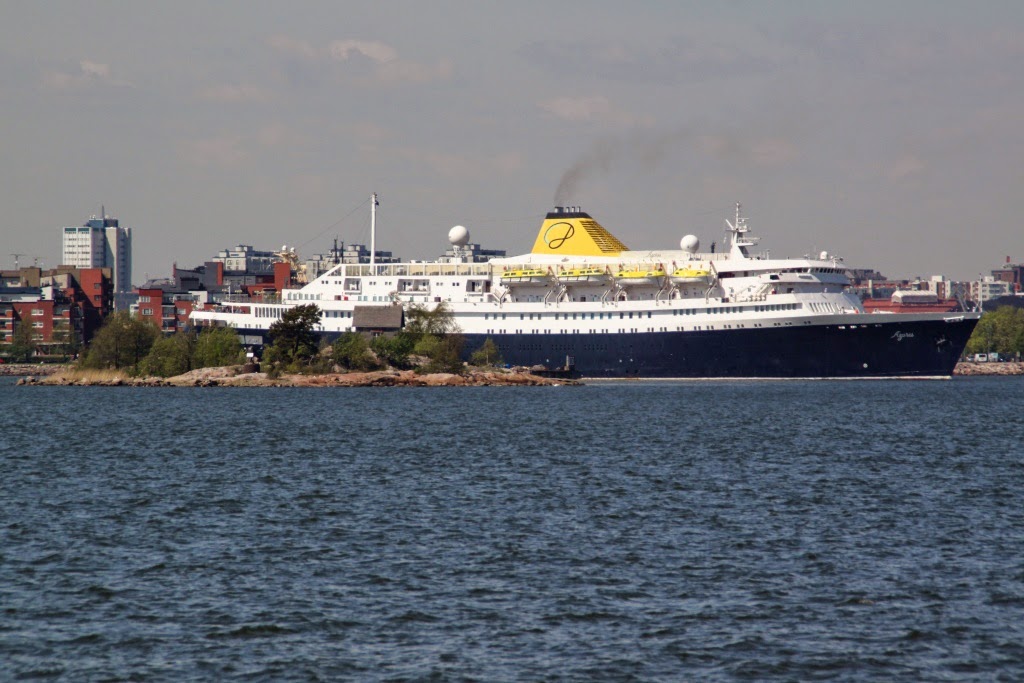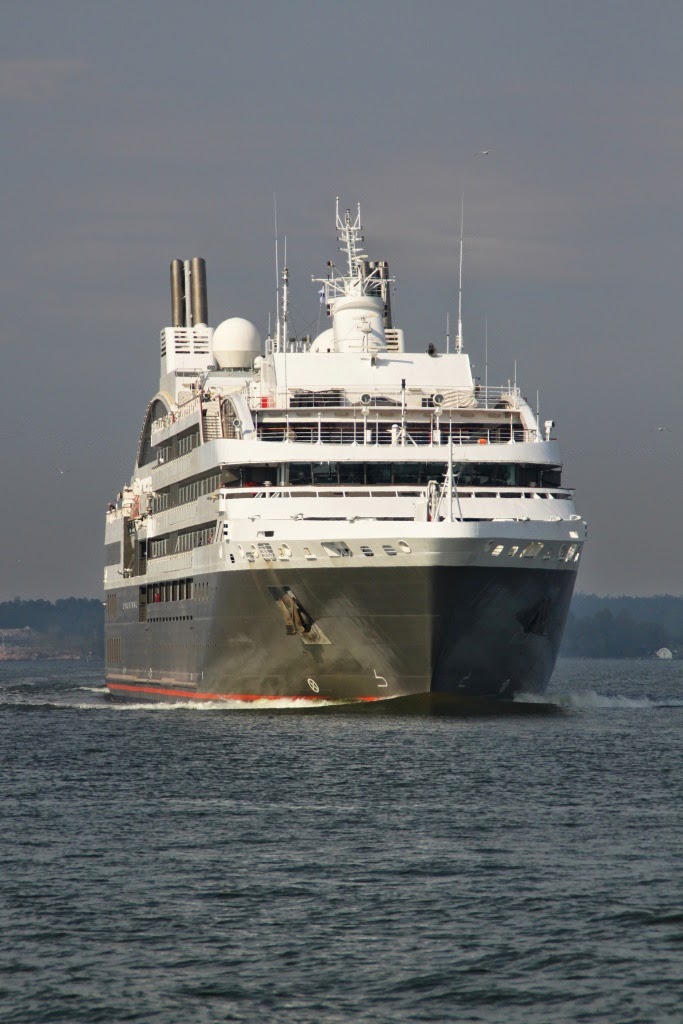Azores
IMO 5383304
Name history:
Stockholm, Völkerfreundschaft, Volker, Fridtjof Nansen, Italia I, Italia Prima, Valtur Prima, Caribe, Athena, Azores
Built 1948, Götaverken Gothenburg,Sweden
Tonnage 16 144 GT
Length 160,08 m
Width 21,04 m
Draught 7,90 m
650 passengers
2 Wärtsilä diesels, combined 10 664 kW
2 propellers
1 bow thruster
Speed 16,5 knots
Today saw two firsts, one for me and one of a more general note. On the latter, today saw the first visit of Portuscale Cruises' 1948-built
Azores in Helsinki under her current name. To photograph her, I headed for the first time to the fortification island Lonna outside Helsinki. The island was opened to the public only this week, so these are literally very new.
Since the
Azores was featured in this blog the last time while she was still the
Athena of Classic International Cruises, this is a good time to update her history. Most of this is just an update of her previous history, with the new bits added to the end.
The
Azores was built way back in 1948 for Svenska Amerika Linjen
(Swedish American Line, SAL) for their Gothenburg-New York -service as
the
Stockholm. The ship took her name from a previous
Stockholm, completed in 1941 by an Italian shipyard but never entered service for SAL due to the war. Whereas the 1941
Stockholm was luxurious to the extreme, the post-war
Stockholm
was originally a rather austere people-carrier not at all in keeping
with SAL's pre-war luxury image. It was not the SAL's intention to turn
into a second-rate operator however, as during the same year the
Stockholm entered service, plans for a new ship, larger and more luxurious than the
Stockholm were being put in motion.
After the new, more luxurious
Kungsholm entered service in 1953, the
Stockholm
was given a large-scale refit in order to get her to match the quality
of her newer fleetmate. In 1956 she was given another refit, when Dennt
Brown -type stabilisers were installed to help the combat the ship's
pronounced rolling. Soon afterwards the ship was involved in an
collision that would make her famous forever. Due to a navigational
error, the
Stockholm rammed the Italian Line liner
Andrea Doria in fog outside of Nantucket. The
Stockholm's
bow was demolished but the ship stayed afloat. The
Andrea Doria was not so
lucky, and sunk 11 hours later. Fortunately, only 46 people onboard the
Andrea Doria and five people onboard the
Stockholm perished in the accident.
The
Stockholm's bow was subsequently repaired and she resumed sailings.
Her SAL career was already coming to an end, as the company's new
flagship
Gripsholm, an improved version of the Kungsholm, was
already under construction in Italy. SAL wanted to sell the
Stockholm
immediately on the Gripsholm's delivery in 1957, but could not find a buyer. A buyer was eventually found in 1959, in the form of the state-owned East German operator
VEB Deutsche Seereederei, who took delivery of the ship in 1960.
Under the East German flag the ship was renamed
Völkerfreundschaft for further cruising. From 1966 onwards the
Völkerfreundschaft spent several winters under chater to
Stena Line,
who used on cruises out of Gothenburg extending as far as the Caribbean. She
remained in service for the East Germans until 1985, when she was sold
to Neptunus Rex Enterprises, Panama, following the delivery of the newer
Arkona (today the
Saga Pearl II). The
Völkerfreundschaft was renamed
Volker and laid up. In 1986 she was renamed
Fridtjof Nansen for use as an accommodation ship in Oslo.
Three years later the aged
Fridtjof Nansen got a new lease of life when sold to StarLauro (the future
MSC Cruises) to be radically rebuilt into a cruise ship in Genoa, potentially to be renamed
Surriento
after a previous Lauro liner. However, it was not until 1992 that the
rebuilding actually started. A year later the ship was renamed
Italia I, later amended into
Italia Prima.
In 1994 the ship was delivered to Nina Cia. di Navigazione (StarLauro
having resold her) and entered service on Mediterranean cruises. In 1995
the
Italia Prima was chartered for five years to Neckermann
Seereisen of Germany and used for Caribbean cruising. Neckermann got
into financial difficulties in early 1998 and the ship was laid up.
In late 1998 the
Italia Prima was chartered to another German tour operator, Valtur Tourist, as the
Valtur Prima for further Caribbean cruising. In 2001 the
Valtur Prima war laid up in Havana, Cuba. The next year the ship was sold to Festival Cruises and renamed
Caribe for planned Caribbean cruising out of Havana, but this never took place and the ship remained laid up for three more years.
In 2005 the
Caribe was finally reactivated. She was sold to the
Portugal-based Classic International Cruises, specilising in the
operation of older tonnage. CIC renamed the ship
Athena and used
her for around-the-world cruising. Interestingly, she cruised winter
seasons for the Australian market. In 2009 the ship was briefly
chartered to Phoenix Reisen after they had trouble taking the delivery
of their new
Alexander von Humboldt.
In September 2012 the
Athena was arrested in Marseille alongside her fleetmate
Princess Danae,
due to alledged unpaid crew wages and fuel bills. Classic International Cruises was declared bankrupt in December of the same year. In February 2013 the
Athena, alongside the bulk of the CIC fleet, was sold to Portugese entrepreneur Rui Alegre, who established Portuscale Cruises (named after Portus Cale, a Roman-era port in present-day Portugal) to operate his acquisitions. The former CIC ships were at the same time given names related to Portugese geography, with the
Athena becoming the
Azores. The
Azores spent all of 2013 either laid up or being refitted, until in spring 2014 she was reactivated for cruising with Germany's Ambiente Kreutzfahrten. Despite the charter to Ambiente, the ship sails painted in full Portuscale colours.
The photoraphs below show the
Azores on Kruunuvuorenselkä shortly after departing Helsinki South Harbour, on the afternoon of 22 May 2014. Photographed from Lonna. Click on the images to see them in larger size.
 |
| The Azores shortly after departing the Katajanokka cruise quay. Unfortunately the ship took the more northernly shipping lane through Kruunuvuorenselkä, which means these photos don't show the Lonna vantage point at its best (though these are still the best possible photos that could have been taken at such an early departure time). |
 |
| Today the Gods of Weather smiled on me, providing a nice amount of photogenic background clouds on an otherwise clear sky. |
 |
| The Portuscale Cruises livery looks fantastically classic - although I would maybe have chosen a shade of yellow closer to buff for that extra traditional effect. |
 |
| Leaving the clouds behind. |
 |
| Just a ten minutes' ferry ride from central Helsinki you have this landscape, which could be from anywhere in the Finnish countryside (as long as there would be water, which there usually is). Of course, few other places have cruise ships as a part of their daily routine. |










































